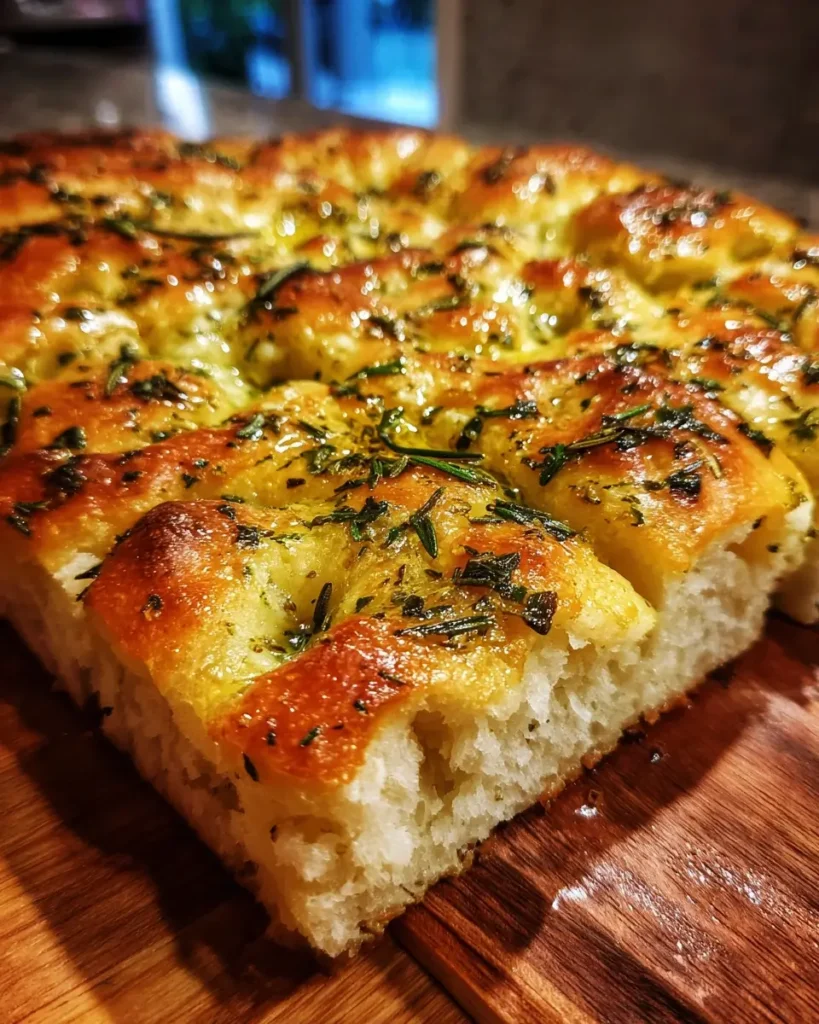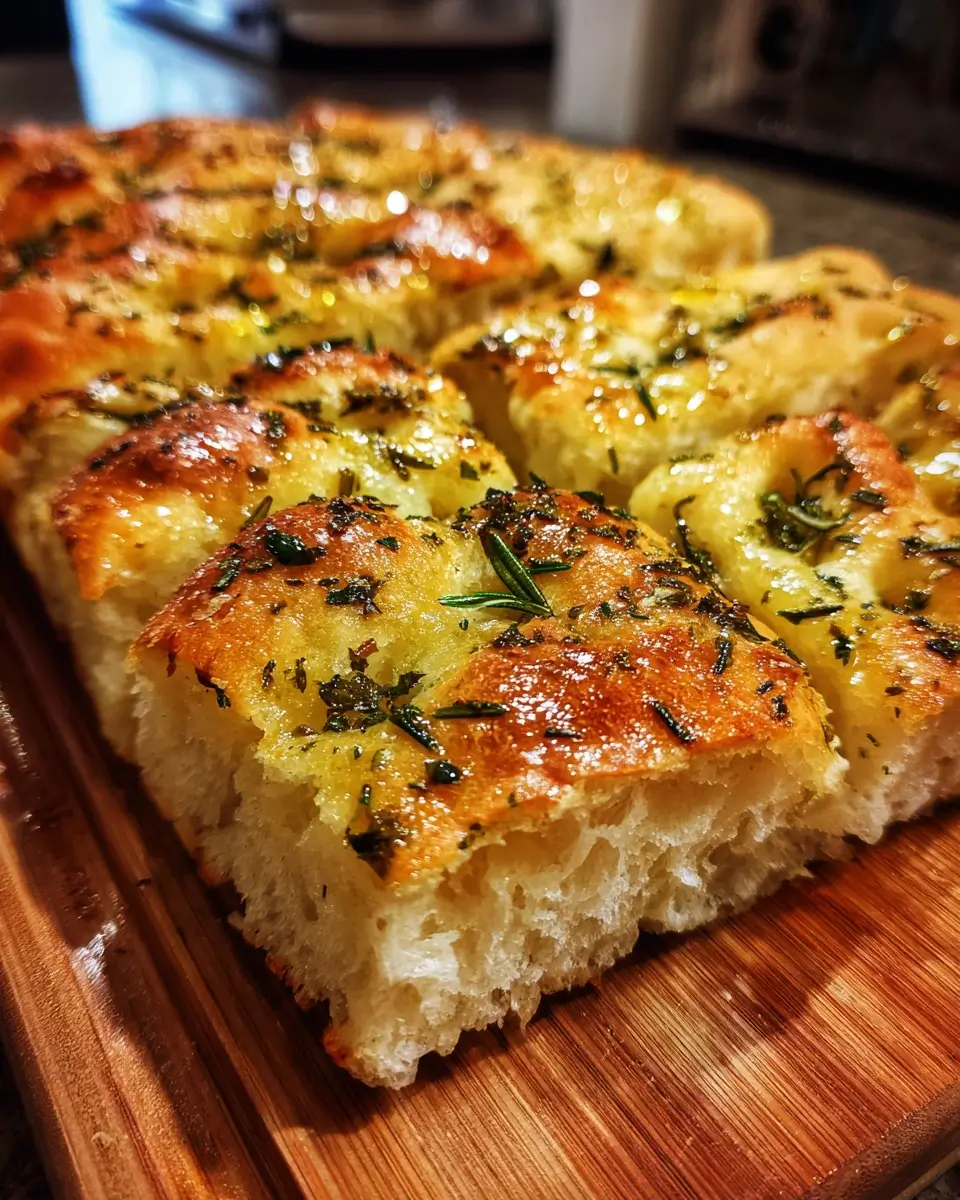Are you craving that authentic Italian bakery experience right in your own kitchen? Look no further than this incredible homemade focaccia bread recipe! This golden, pillowy bread studded with fresh herbs and drizzled with aromatic garlic butter will transport your taste buds straight to the Mediterranean coast. Best of all, you don’t need to be a master baker to achieve spectacular results!
Why This Homemade Focaccia Bread Will Become Your New Favorite
There’s something truly magical about pulling a tray of freshly baked focaccia from the oven. The intoxicating aroma of herbs and garlic fills your kitchen, while the golden dimpled surface promises incredible texture and flavor with every bite. This recipe strikes the perfect balance between crispy exterior and soft, airy interior that makes focaccia so beloved worldwide.
What makes this particular recipe stand out is its foolproof nature. Even if you’ve never attempted bread baking before, these straightforward instructions will guide you to success. The dough is incredibly forgiving, requiring minimal handling and no special equipment. Plus, the versatility of this bread means it can complement virtually any meal, from a simple soup to an elaborate Italian feast.
The combination of fresh rosemary, thyme, and sage creates a fragrant herb medley that infuses the bread with classic Mediterranean flavors. Meanwhile, the garlic-infused butter adds a rich depth that elevates this focaccia from good to absolutely unforgettable.
Essential Ingredients for Perfect Focaccia
To create this incredible bread, you’ll need:
- 4 cups all-purpose flour
- 2 teaspoons instant yeast
- 2 teaspoons salt
- 2 cups warm water
- 4 tablespoons olive oil (divided)
- 2 tablespoons fresh rosemary
- 2 tablespoons fresh thyme
- 1 tablespoon fresh sage
- 4 garlic cloves, minced
- 2 tablespoons butter, melted
- Sea salt for topping
Tools You’ll Need
One of the beauties of focaccia is its simplicity. You’ll only need basic kitchen equipment:
- Large mixing bowl
- Wooden spoon or spatula
- Measuring cups and spoons
- Baking sheet (approximately 13×18 inches)
- Clean kitchen towel for covering dough
- Small bowl for mixing garlic butter
Ingredient Substitutions and Additions
Don’t have all the exact ingredients? No problem! This recipe is highly adaptable:
- Herbs: While the combination of rosemary, thyme and sage is classic, you can use whatever fresh herbs you have available. Oregano, basil, or parsley work beautifully too.
- Flour: All-purpose flour works perfectly, but you can substitute bread flour for a slightly chewier texture.
- Yeast: If you only have active dry yeast instead of instant, simply proof it in the warm water for 5-10 minutes before adding to the dry ingredients.
- Toppings: Feel free to get creative! Try adding sliced cherry tomatoes, caramelized onions, olives, or a sprinkle of parmesan cheese before baking.

Step-by-Step Cooking Instructions
Preparing the Dough
Start by combining 4 cups of all-purpose flour, 2 teaspoons of instant yeast, and 2 teaspoons of salt in a large bowl. Whisk these dry ingredients together to ensure even distribution. Next, add 2 cups of warm water (about 110°F) and 2 tablespoons of olive oil to the bowl.
Using a wooden spoon or sturdy spatula, mix everything together until a shaggy, somewhat sticky dough forms. Don’t worry about kneading – that’s the beauty of focaccia! The texture should be wet but still manageable. If it seems excessively sticky, you can add a tablespoon of flour, but resist the urge to add too much as a wetter dough creates those beautiful air pockets.
Cover the bowl with a clean kitchen towel or plastic wrap and place it in a warm, draft-free spot in your kitchen. Let the dough rise for about an hour, or until it has doubled in size.
Shaping and Second Rise
Once your dough has doubled, prepare your baking sheet by drizzling the remaining 2 tablespoons of olive oil across the surface. The generous amount of oil might seem excessive, but it’s essential for achieving that characteristic focaccia texture and flavor.
Gently transfer the risen dough to the oiled baking sheet. Instead of punching down the dough (as you might with other bread recipes), use your fingertips to carefully stretch it to fill the pan. Take your time with this step, allowing the dough to rest if it starts resisting too much.
After stretching the dough to the edges of the pan, use your fingertips to create those signature focaccia dimples across the entire surface. These indentations serve both practical and aesthetic purposes – they prevent the dough from rising unevenly and create perfect little pools for your herbs and garlic butter.
Press your fresh herbs (rosemary, thyme, and sage) into the dimples, distributing them evenly across the surface. Cover the dough again and allow it to rise for another 30 minutes.
Baking to Golden Perfection
While the dough completes its second rise, preheat your oven to 425°F. This high temperature is crucial for achieving the perfect texture.
In a small bowl, combine the melted butter with minced garlic, stirring well to infuse the butter with garlicky goodness. Just before baking, drizzle this aromatic garlic butter over the dimpled dough, making sure it pools in those little indentations. Finish with a generous sprinkle of flaky sea salt.
Bake in the preheated oven for 20-25 minutes, or until the top is beautifully golden brown and the kitchen is filled with an irresistible aroma. The exact baking time may vary depending on your oven, so start checking at the 18-minute mark.
Once baked, allow your homemade focaccia bread to cool on the pan for about 10 minutes before transferring to a wire rack. This short rest allows the structure to set, making it easier to slice.
Perfect Pairings for Your Focaccia
This versatile bread shines in numerous settings:
- Serve warm alongside a bowl of hearty minestrone soup
- Use as a base for an elevated sandwich with Italian cold cuts and cheeses
- Cut into smaller pieces for dipping in high-quality olive oil and balsamic vinegar
- Serve alongside a charcuterie board for an impressive appetizer spread
- Pair with a fresh garden salad for a simple yet satisfying lunch
Pro Tips for Focaccia Success
For truly exceptional results, keep these tips in mind:
- Temperature matters: Ensure your water is warm (around 110°F) but not hot, which would kill the yeast.
- Don’t skimp on oil: The generous amount of olive oil is essential for authentic flavor and texture.
- Fresh herbs make a difference: While dried herbs can work in a pinch, fresh herbs provide superior aroma and visual appeal.
- Let the dough be sticky: Resist the urge to add extra flour – a wetter dough creates that airy texture.
- Create those dimples: Don’t skip the dimpling step, as it’s crucial for proper texture and creates perfect pockets for herbs and oil.
Storing Your Focaccia
Focaccia is best enjoyed fresh on the day it’s baked, but you can store leftovers in an airtight container at room temperature for up to 2 days. For longer storage, wrap tightly and freeze for up to 1 month.
To refresh day-old focaccia, sprinkle with a few drops of water and warm in a 350°F oven for 5-10 minutes. This restores much of the original texture and brings back that fresh-baked flavor.
Nutritional Information
Each generous slice of this homemade focaccia bread (assuming 12 slices per recipe) contains approximately:
- Calories: 210
- Carbohydrates: 32g
- Protein: 4g
- Fat: 7g
- Fiber: 1g
- Sodium: 390mg
Frequently Asked Questions
Can I make the dough ahead of time?
Absolutely! You can prepare the dough and refrigerate it for up to 24 hours for the first rise. This actually enhances flavor development. Let it come to room temperature before proceeding with shaping.
Why is my focaccia not rising properly?
Check that your yeast is fresh and that your water wasn’t too hot. Also, ensure your rising environment is warm enough – around 75°F is ideal.
Can I use dried herbs instead of fresh?
Yes, though you’ll need to reduce the quantities by about two-thirds, as dried herbs are more potent than fresh.
How do I know when my focaccia is fully baked?
The top should be golden brown, and if you tap the bottom, it should sound hollow. An instant-read thermometer inserted into the center should read around 200°F.
Bringing Mediterranean Magic to Your Table
There’s something deeply satisfying about creating homemade focaccia bread from scratch. The process itself – mixing the simple ingredients, watching the dough rise, creating those signature dimples, and finally experiencing the incredible aroma as it bakes – becomes a form of culinary therapy.
What makes this recipe particularly special is how it transforms humble ingredients into something truly extraordinary. The combination of herbs, garlic, and good olive oil creates layers of flavor that commercial breads simply can’t match. Plus, the pride that comes from placing a beautiful loaf of homemade bread on your table is absolutely priceless.
Whether you’re a seasoned baker or a complete novice, this focaccia recipe deserves a place in your regular rotation. It’s impressive enough for special occasions yet simple enough for weeknight dinners. So gather your ingredients, roll up your sleeves, and prepare to experience the joy of creating authentic Italian focaccia in your own kitchen!

